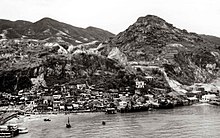
| Cha Kwo Ling | |||||||||||||
|---|---|---|---|---|---|---|---|---|---|---|---|---|---|
| Traditional Chinese | 茶果嶺 | ||||||||||||
| Simplified Chinese | 茶果岭 | ||||||||||||
| Cantonese Yale | chàh gwó léhng | ||||||||||||
| |||||||||||||


Cha Kwo Ling (Chinese: 茶果嶺) is a hill in the eastern New Kowloon area of Hong Kong, and the area around it. It is adjacent to Victoria Harbour and located to the west of Yau Tong and southwest of Lam Tin. Administratively, it belongs to the Kwun Tong District. The northeastern entrance to the Eastern Harbour Crossing is located in this area.
The Cha Kwo Ling Village (茶果嶺村), described as one of the last squatter villages in Hong Kong,[1] has a population of approximately 2,400. It is located approximately 1.4 km (0.87 mi) northwest of Lei Yue Mun, adjacent to the Laguna City development.[2] It lies at the foot of the hill and stretches along Cha Kwo Ling Road, which was built on reclaimed land and separates the village from the coast.[3] In the 2019 and 2020 policy addresses, the chief executive stated that the government intends to take back possession of the Cha Kwo Ling Village and to redevelop the land into high-density public housing.[4][5]
Cha Kwo Ling derives its name from the abundance of macaranga tanarius in the area, the leaves of which are used in the process of making cha kwo, a traditional Hakka snack.[6]
- ^ Ng, June (13 May 2010). "Still Standing". HK Magazine. Archived from the original on 2011-01-29. Retrieved 17 July 2011.
- ^ "Fun in Kwun Tong - Heritage & Attractions". Archived from the original on 2009-03-13. Retrieved 2009-09-10.
- ^ Antiquities and Monuments Offices - Introduction to 1444 Historic Buildings, item No.1242 Archived October 13, 2012, at the Wayback Machine
- ^ "Policy Address". The Chief Executive's 2020 Policy Address. 25 November 2020. Retrieved 20 February 2021.
- ^ "LCQ2: Development plans for three squatter areas". Development Bureau. 3 June 2020. Retrieved 20 February 2021.
- ^ https://www.kwuntong.org.hk/publications/KTbook.pdf [bare URL PDF]
